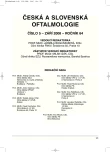Microbiological Examination of the Aqueous Humor after Implantation of the Intraocular Lens CORNEAL
Authors:
N. Jirásková; P. Rozsíval; J. Pozlerová; M. Ludvíková
Authors‘ workplace:
Oční klinika Lékařské fakulty Univerzity Karlovy a Fakultní nemocnice, Hradec Králové, přednosta prof. MUDr. P. Rozsíval, CSc.
Published in:
Čes. a slov. Oftal., 64, 2008, No. 5, p. 185-187
Overview
Purpose:
To compare the results of the microbiological examination of aqueous humor after implantation of the intraocular lens (IOL) CORNEAL using either injector or forceps.
Materials and methods:
In this prospective randomized clinical study 46 eyes (43 patients) were implanted with the hydrophylic acrylic IOL CORNEAL ACR6D SE. Injector was used in 23 eyes and folding and implantation forceps in 23 eyes. After delivery of the IOL in the capsular bag, viscoelastic material was removed using bimanual I/A and the specimen for microbiological examination was obtained. The anterior chamber was filled with balanced salt solution, intracameral antibiotics were injected and the stroma alongside the primary incision and the side port incisions were lightly irrigated to form a fairly secure seal.
Results:
The results of primary cultivation were negative in all specimen. Only threetimes sporadic colonies of Staphylococcus plasmacoag. neg. were isolated from the liquid medium after reincubation, that were described by microbiologist as very probably contamination of the sample. At two from these three cases forceps were used for implantation, once injector. Anaerobic and mycologic examinations of all samples were negative. There was no evidence of postoperative inflammation in any case.
Conclusion:
Both implantation techniques proved to be safe with no significant differences comparing the microbiological examination and postoperative outcome.
Key words:
intraocular lens, implantation, injector, forceps
Sources
1. Baráková, D., Kuchynka, P., Cihelková., I.: Implantace čočky AcrySof MA30BA systémem Monarch. Čes. a slov. Oftal., 58, 2002: 149-152
2. Dhaliwal, DK., Mamalis, N., Olson, RJ.: Visual significance of glistening seen in the AcraSof intraocular lens. J Cataract Refract Surg., 22, 1996: 452-457.
3. Holladay, JT.: International Intraocular Lens & Implant Registry 2004. J Cataract Refract Surg, 30, 2004: 209-210.
4. Izak, AM., Werner, L., Pandey,SK. et al.: Calcification of modern foldable hydrogel intraocular lens designs. Eye, 17, 2003: 393-406.
5. Jirásková, N.: Měkké nitrooční čočky – nový trend v implantologii (souborný referát). Čes. a slov. Oftal., 53, 1997: 337-341.
6. Jirásková, N., Rozsíval, P., Liláková, D. et al.: Výsledky prospektivní klinické studie 150 implantovaných AcrySof čoček. Čes. a slov. Oftal., 57, 2001: 88-91.
7. Jirásková, N., Rozsíval, P., Kohout, A.: Opacifikace hydrofilních akrylátových nitroočních čoček. Čes. a slov. Oftal., 63, 2007, 6: 390-395.
8. Johnem, T.: The variety of foldable intraocular lens materials. J Cataract Refract Surg 1996; 22 (Suppl 2):1255-1258.
9. Rozsíval, P., Jirásková, N.: Implantace měkké silikonové nitrooční čočky. Čes. a slov. Oftal., 52, 1996: 210-214.
Labels
OphthalmologyArticle was published in
Czech and Slovak Ophthalmology

2008 Issue 5
Most read in this issue
- Benign Masquerade Syndromes in Differential Diagnosis of Uveitis
- Long Term Outcomes of Chronic Abducens Palsy Surgical Treatment in Children and Adults
- 3D Ultrasonography Diagnostics of the Eye and Orbit
- Ophthalmic Complications after the Embolization of the Internal Carotid Artery – a Case Report
